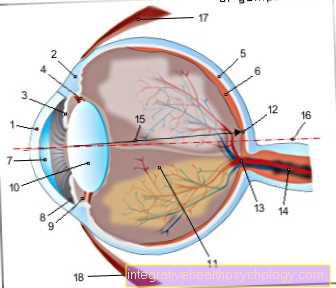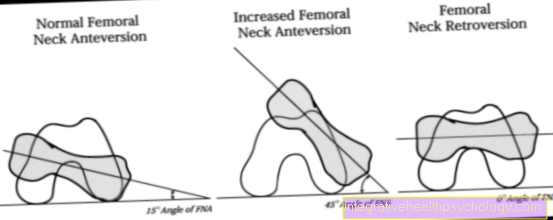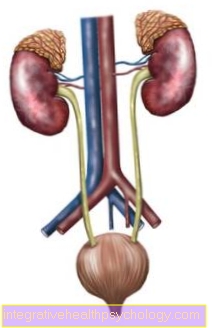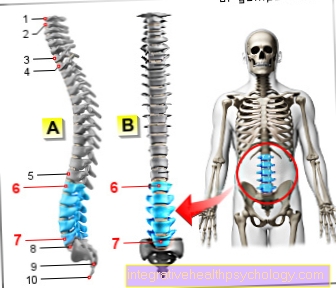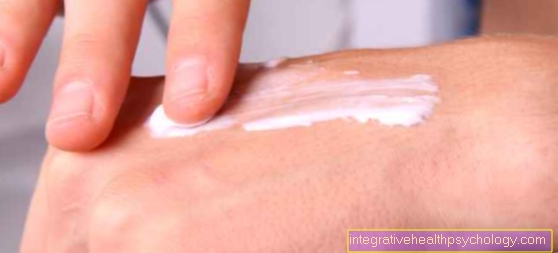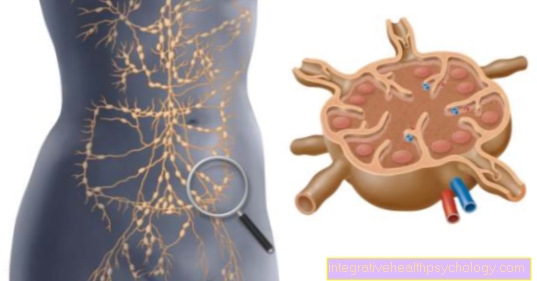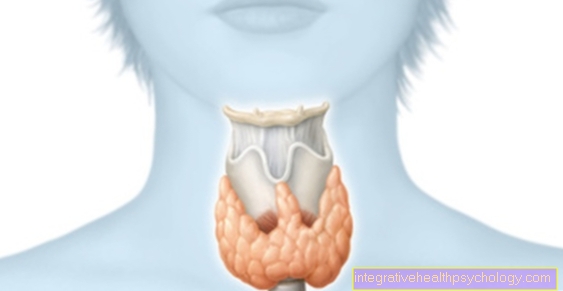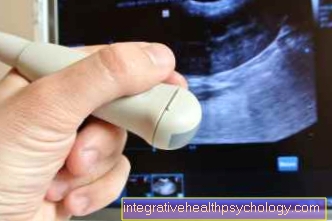Fistulous duct
introduction
Fistulas are pathological connections between different organs or tissue layers that are naturally absent. These arise, for example, as a result of an injury or inflammation or due to an illness.
Depending on the organ of origin, blood, pus or other body secretions may leak through the fistula.

How does a fistula occur?
The formation of a fistula is often based on an inflammatory process in the body. If, for example, an encapsulated purulent inflammation of an organ (abscess) occurs, a fistula can develop through which the body tries to evacuate the pus.
Fistulas can sometimes develop from naturally existing ducts. One example is the small anal glands that open into the rectum. If inflammation develops there due to immigrating intestinal bacteria, a fistula can form that emerges through the skin. The division and growth of cells creates an internally lined and sealed fistula duct. Depending on the place of origin, body secretions or pus may get through this fistula.
A distinction must be made between these pathological fistulas and the connection paths created by medical intervention, some of which are also referred to as fistulas. One example of this is the gastric fistula, which is created for artificial feeding of a person who can no longer swallow food.
This fistula duct is artificially created as part of a gastroscopy. The gastric fistula is also known as a percutaneous endoscopic gastrostomy (PEG), which means the connection between the gastric cavity and the surface of the body through the skin.
also read: Fistula
What causes a fistula?
The cause of the formation of a fistula is usually either injuries or inflammation. In addition, there are congenital fistulas, for example in the case of incomplete regression in the course of embryonic development, but which are not caused by inflammatory processes.
In the case of fistulas caused by inflammation, there are certain diseases in which fistula ducts are particularly common. One example is inflammatory bowel disease, Crohn's disease.
With this condition, foci of inflammation can appear throughout the digestive tract. Since all layers of the intestinal wall are usually affected in Crohn's disease, this disease often results in fistulas that emanate from the intestinal loops. These fistulas can grow into another loop of the intestine or other organs such as the urinary bladder or vagina. In addition, the ducts can also grow towards the surface of the body so that they emerge from the skin.
Another possible cause for the development of intestinal fistulas are so-called diverticula. A great many adults (especially those who are overweight and have little exercise) are affected by these bulges in the intestinal wall. The diverticula can become inflamed, which results in an acute serious illness, but fistulas can also develop here from the protrusions.
Other causes for the development of fistulas due to inflammation are untreated tooth root abscesses or hair root abscesses, for example on the tailbone.
Another cause is fistulas that arise as a result of an injury during medical intervention, for example if the organ wall is accidentally injured by a colonoscopy. Another possible cause for the development of a fistula duct as a result of a medical intervention is the irradiation of a tumor, for example.
Read also under:
- Crohn's disease
- Diverticulitis
Treatment of a fistula duct - OP
When a fistula has formed, there are often no treatment alternatives to surgery.
Whether or which intervention is indicated depends on the one hand on which organs are affected, where the fistula is located and what the causes are. It is also important whether the fistula causes symptoms or whether there is a risk of complications such as inflammation if the treatment is not carried out.
Depending on the situation, the fistula duct is either peeled out or split through a longitudinal incision, exposed and cleaned during the operation. The latter is also known as a fistulotomy.
An alternative treatment method to surgery is the so-called thread drainage. With some anal fistulas, a silicone thread can be inserted into the fistula so that it heals without surgery. In the case of recurring fistulas such as the chronic inflammatory bowel disease Crohn's disease, this procedure can also counteract the formation of new fistula ducts.
Risks of a fistulous duct
The risks of an untreated fistulous duct depend on which organs are involved and what the cause is.
If there is a fistula between the intestine and the urinary bladder, there is a risk of recurring and serious urinary tract infections when intestinal germs enter the bladder.
In addition to severe pain, untreated anal fistulas can lead to damage to the sphincter muscle in the course of a loss of continence. In addition, an inflamed fistula can, in the worst case, lead to life-threatening blood poisoning. The risks due to the fistula are offset by the risks of surgical removal, which must be weighed against each other in each individual case.
There are general risks involved
- Bleeding,
- Inflammation,
- Wound healing disorders and
- possibly side effects from anesthetics.
In turn, specific risks depend on the location of the fistula duct. This can lead to injuries to surrounding structures such as nerves, blood vessels or hollow organs.
Duration of a fistula
Depending on the cause and size, a fistula can develop within a few days with an acute inflammation or it can grow slowly over a longer period of time. Inflammation can heal quickly with targeted treatment, but the fistula does not disappear on its own but remains until surgical removal, if necessary.
The duration of such an intervention depends on various factors such as the size, extent and location of the fistula. In the case of a simple coccyx fistula, the actual operation often only takes a few minutes, while complicated fistula ducts between internal organs can also require more complex operations over several hours.
Can a fistula also heal on its own?
A fistula can usually not heal on its own, especially not those that have formed between the internal organs.
However, surgery does not have to be carried out immediately for every fistula. The attending physician will make a recommendation through an examination as to whether the fistula requires surgical removal or whether it is possible to wait and see.
In some cases, as an alternative to surgery, for example with anal fistulas, a silicone thread can be inserted into the fistula duct. Secretion should drain through this and the fistula should dry out. In the best case, the fistula can heal without surgery.
Fistula on the coccyx
The fistula duct on the coccyx is a special form of fistula and even has its own name with “Sinus pinolidalis”. It is a fistula, the origin of which is the inwardly growing hair in the area of the gluteal fold.
Overweight men with heavy hair are particularly affected. Other favorable factors for the development of a fistula on the tailbone are poor hygiene, a weakened immune system and prolonged sitting.
The symptoms are usually pain and itching. Inflammation of the fistula ducts on the coccyx can also lead to the escape of blood or pus. As a treatment method, only surgical removal of the fistula is usually promising.
However, new fistulas often form again. Therefore, weight loss, thorough hygiene measures and sufficient exercise should try to counteract the recurrence.
You might also be interested in: Fistula in the genital area
Fistula on the anus
A fistula duct on the anus is a duct that usually starts from the anal canal and is usually caused by the inflammation of so-called procteal glands. These glands are located in the intestinal lining at the transition from the large intestine to the rectum. Immigrating intestinal bacteria can inflame the glands from within and lead to the formation of a fistula. This usually manifests itself as itching, oozing or pain in the area of the anus.
In most cases, an anus fistula should be treated surgically as soon as possible. Failure to provide or delay treatment can otherwise lead to a widening of the fistula and an increase in symptoms. In some cases, the sphincter muscle can also be affected by the fistula, so that it can even be damaged. This can result in a loss of continence so that one can no longer hold the chair.
It is therefore advisable to consult a doctor with the described complaints about the anus so that he can carry out an examination and, if necessary, initiate treatment promptly.
Learn more at: Fistula on the anus
Fistula duct in the intestine
The intestine is a common organ of origin for fistula ducts. One can distinguish between internal fistulas, which lie between the internal organs, and external ones, which connect the intestine to the body surface via the skin.
In the internal fistula there is either a connection between two intestinal loops or between the intestine and another organ, such as the urinary bladder.
Fistulas in the intestine are usually caused by inflammations such as diverticulitis (inflammation of protuberances in the intestinal wall) or Crohn's disease (chronic inflammatory bowel disease).
Whether a fistula must be treated or not depends on the location, the organs involved and the possible consequences of a lack of treatment. If removal is necessary, this can usually only be done through an operation. If treatment does not seem necessary, regular check-ups may be carried out.
Learn more: Fistula in the intestine
Fistula duct in the groin
A groin duct, like other fistulas, can be the result of encapsulated inflammation. Pus can drain through the passage.
This must be distinguished from so-called AV fistulas (arterio-venous fistula), which can arise, for example, as a result of a cardiac catheter examination via the groin. This is a connection between artery and vein as a result of an injury to the vessel walls from the medical procedure. Since the AV fistula leads to a disturbance of the blood flow, this often has to be corrected surgically.
Find out more at: AV fistula - you should know that!
Fistula on the tooth
A fistula on the tooth is usually the result of an untreated inflammation of the tooth root (or the tooth pulp). The tooth nerve dies and the necrosis forms pus, which initially cannot escape. The body then forms a fistulous duct through which the pus can then flow into the oral cavity or, less often, outward to the skin of the face.
The emptying usually does not cause pain. A fistula is therefore often an incidental finding at the dentist. Root canal treatment or extraction clears the inflammation and the fistulous duct.
Read more at:
- Fistula on the tooth
- Fistula on the gums
Recommendations from the editorial team
You might also be interested in:
- fistula
- Fistula on the navel
- Fistula in the intestine
- Fistula on the anus
- Fistula in the genital area
- Fistula in the mouth
- Fistula on the gums
- Throat fistula
- AV fistula






